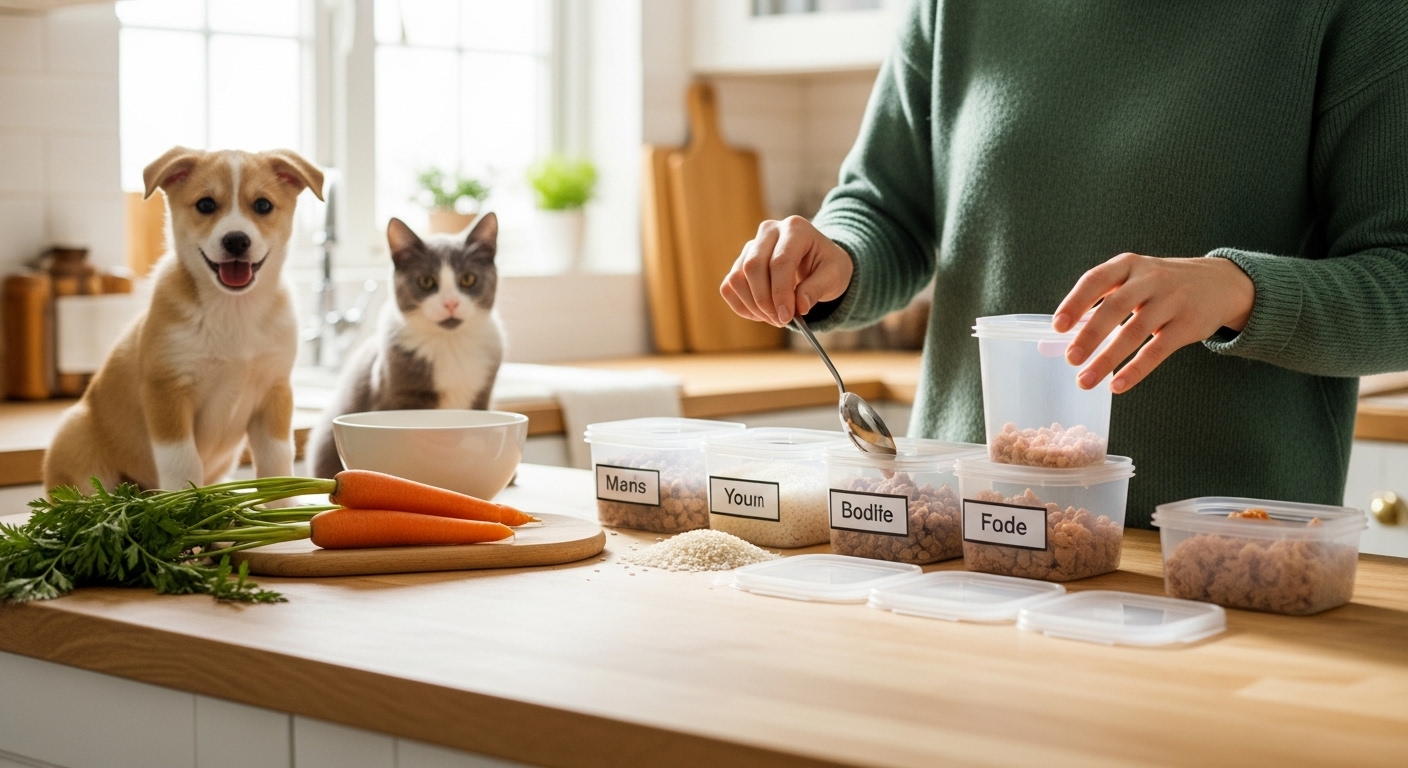From wagging tails to tiny toe beans, here’s your ultimate guide to starting strong.
So, you’ve decided to welcome a furry friend into your life—cue the happy tail wags and purring snoozes! 🎉 Becoming a first-time pet parent is a beautiful journey filled with love, learning, and let’s be honest… a few surprises. Whether you’re bringing home a playful pup or a curious kitten, one thing’s for sure: you want to give them the best life possible from day one.
But where do you start? What do you feed them? How do you prep your home? What should you really expect in those first few weeks?
Don’t worry, bestie—I’ve got you.
In this guide, I’ll walk you through the basics of pet parenting, especially focusing on something many overlook: meal prep and batch cooking for your dog or cat. Because feeding them well = loving them well. 🐾
🐕 Why Meal Prep for Pets?
Just like humans, our pets thrive on balanced, consistent meals. Meal prepping for pets is gaining popularity for a good reason—it saves time, helps control ingredients, reduces costs, and supports their health with whole, fresh foods.
Whether you’re planning to cook meals at home or add some healthy homemade touches to their commercial food, having a meal prep routine can make life easier and your pet happier.
Benefits of meal prep for pets:
- Helps maintain a stable diet with minimal guesswork
- Reduces reliance on processed ingredients and fillers
- Allows you to cater to allergies or sensitivities
- Makes feeding time less chaotic (especially in busy households!)
- Strengthens your bond—your pet will love your cooking! 😋
🧡 First-Time Pet Parent Prep Checklist
Before diving into the meal prep magic, let’s cover the basics every new pet parent should know:
1. Create a Pet-Friendly Space
- Choose a quiet spot for their bed, crate, or favorite nap corner.
- Keep wires, houseplants (some are toxic!), and breakables out of reach.
- Have bowls, toys, and a litter box or potty pad ready to go.
2. Gather Must-Have Supplies
You’ll need:
- Bowls (one for water, one for food)
- Collar, ID tag, and leash
- Litter box (for cats)
- Crate or travel carrier
- Toys, grooming tools, and a comfy bed
- Vet-approved flea/tick and worm treatments
3. Find a Vet Early
Schedule your first check-up within a week of bringing your pet home. Ask about vaccines, microchipping, spaying/neutering, and get their weight and breed-specific health info.
4. Learn Basic Pet Nutrition
This is where the meal prep magic really starts! Pets need a mix of:
- Proteins: Chicken, beef, turkey, fish, or eggs
- Carbohydrates: Rice, quinoa, or oats (in moderation)
- Vegetables: Carrots, peas, pumpkin, or green beans
- Healthy fats: Salmon oil, olive oil, or coconut oil
- Supplements (optional): Vet-approved vitamins, probiotics, or calcium
Note: Cats are obligate carnivores, meaning they need more meat and very little (if any) carbs. Dogs are more omnivorous and can enjoy a variety.
🍲 Easy Batch Cooking Recipes for Pets
Here are two easy, nutritious meal-prep-friendly recipes for your new fur baby. Always check with your vet before changing your pet’s diet.
🐶 Dog-Friendly Chicken & Veggie Bowl (Makes 5 Servings)
Ingredients:
- 2 chicken breasts (boneless, skinless)
- 1 cup brown rice
- 1/2 cup peas
- 1/2 cup chopped carrots
- 1 tbsp olive oil
Steps:
- Boil chicken until fully cooked, then shred.
- Cook brown rice separately according to package instructions.
- Lightly steam peas and carrots.
- Mix all ingredients together in a large bowl and add olive oil.
- Portion into 5 containers and refrigerate (lasts 3–4 days).
🐱 Cat-Approved Tuna & Pumpkin Puree (Makes 4 Servings)
Ingredients:
- 1 can tuna in water (low-sodium)
- 1/2 cup plain pumpkin puree
- 1/4 tsp fish oil (optional)
Steps:
- Drain tuna and mash with a fork.
- Mix in pumpkin puree and fish oil.
- Serve in small portions with a sprinkle of their dry food (optional).
- Refrigerate unused portions for up to 3 days.
Remember: Cats love their food fresh—don’t leave wet food out for more than 30 minutes.
🧽 Clean-Up & Storage Tips for Batch Cooking
- Use BPA-free containers or small glass jars for storage.
- Label each container with the date.
- Keep in the fridge for up to 3–4 days, or freeze for up to 2 weeks.
- Wash your pet’s bowls daily to avoid bacteria build-up.
- When thawing frozen meals, defrost overnight in the fridge (not at room temp).
⏰ Feeding Schedule for New Pet Parents
Dogs: 2 meals per day (puppies may need 3)
Cats: 2–3 small meals per day (free-feeding can work for some)
Stick to regular meal times and avoid overfeeding. Use a measuring cup and track treats separately—they count toward daily calories too!
🧠 Things to Watch As You Settle In
As you adjust to life with your new pet, keep an eye on:
- Appetite changes – sudden disinterest in food? Talk to your vet.
- Stool consistency – yes, you’ll become a poop detective! Soft or runny stools can signal food intolerance.
- Water intake – pets should drink regularly, but excessive thirst could mean something’s off.
- Behavior shifts – a well-fed pet is usually calm, playful, and alert.
🐾 Final Thoughts: You’ve Got This!
Becoming a first-time pet parent might feel overwhelming at times, but every little effort you make is a step toward a stronger bond and a healthier, happier life for your new best friend.
Meal prep isn’t just about convenience—it’s about care. It’s you saying, “I love you” in every bite. 🧡
So roll up those sleeves, grab a batch of bowls, and start prepping like the amazing pet parent you are. Your furry companion is lucky to have you!

